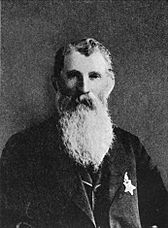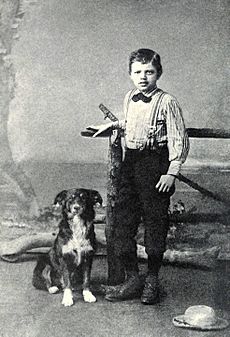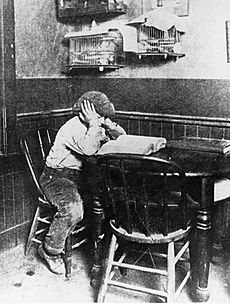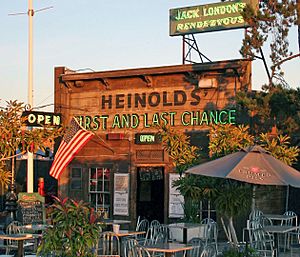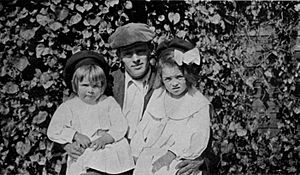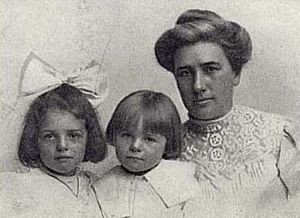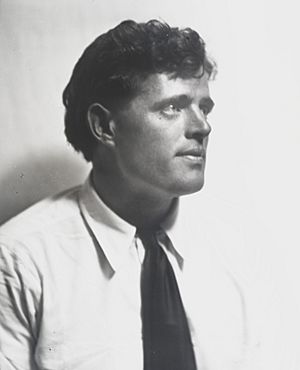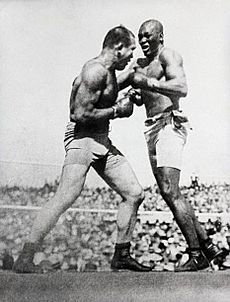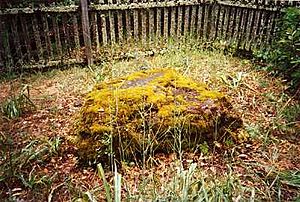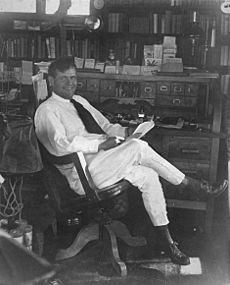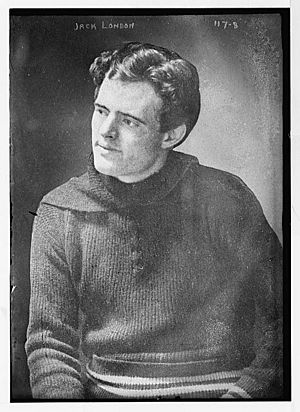Jack London facts for kids
Quick facts for kids
Jack London
|
|
|---|---|
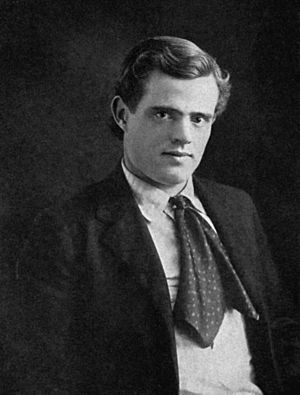
London in 1903
|
|
| Born | John Griffith Chaney January 12, 1876 San Francisco, California, U.S. |
| Died | November 22, 1916 (aged 40) Glen Ellen, California, U.S. |
| Occupation |
|
| Literary movement | Realism, Naturalism |
| Notable works | The Call of the Wild White Fang |
| Spouse |
Elizabeth Maddern
(m. 1900; div. 1904) |
| Children | Joan London Bessie London |
| Signature | |
John Griffith Chaney (born January 12, 1876 – died November 22, 1916), known as Jack London, was a famous American writer. He wrote many novels, short stories, and articles. He was one of the first American authors to become famous worldwide. He also earned a lot of money from his writing.
Jack London was known for his adventure stories. He also wrote about science fiction ideas. He cared deeply about animal rights and workers' rights. He also believed in socialism, a system where society works together for everyone's good.
Some of his most famous books are The Call of the Wild and White Fang. These stories are set in Alaska and the Yukon during the Klondike Gold Rush. He also wrote popular short stories like "To Build a Fire".
Contents
- Jack London's Family Life
- Jack London's Early Adventures
- The Gold Rush and Becoming a Famous Writer
- Jack London's Marriages
- Jack London as a War Correspondent
- Jack London's Ranch Life
- Jack London's Views and Beliefs
- Jack London's Death
- Accusations of Plagiarism
- Jack London's Famous Works
- Legacy and Honors
- Images for kids
- See also
Jack London's Family Life
Jack London was born on January 12, 1876. His mother was Flora Wellman. When Jack was a baby, Flora sent him to be cared for by Virginia Prentiss. Virginia was a kind, formerly enslaved African-American woman. Jack always felt she was a very important mother figure to him. He said she gave him the most love and care when he was a child.
Later in 1876, Flora Wellman married John London. John was a veteran from the American Civil War. Baby Jack then came to live with them. The family moved around the San Francisco Bay Area. They finally settled in Oakland. Jack went to public school there. The Prentiss family also moved with them. They continued to be a steady source of support for young Jack.
Jack London's Early Adventures
Jack London was born in San Francisco. The house where he was born was later destroyed in the fire after the 1906 San Francisco earthquake. Even though his family was working class, they were not as poor as Jack sometimes said later. Jack mostly taught himself.
In 1885, Jack read a long novel called Signa. He said this book inspired him to become a writer. In 1886, he visited the Oakland Public Library. There, he met a helpful librarian named Ina Coolbrith. She encouraged him to keep learning. She later became California's first official poet.
In 1889, Jack started working long hours at a cannery. He wanted a different life. He borrowed money from his foster mother, Virginia Prentiss. He bought a boat called the Razzle-Dazzle from an oyster pirate. Then, he became an oyster pirate himself for a few months.
After his boat was damaged, Jack got a job with the California Fish Patrol. In 1893, he joined a ship that hunted seals. They sailed all the way to Japan. When he came back, the country was in a tough economic time. Oakland had many worker protests. After working hard jobs, Jack joined a group called Coxey's Army. He began traveling around the country as a tramp. In 1894, he spent 30 days in jail for being a vagrant.
After his many adventures, he returned to Oakland. He attended Oakland High School. He wrote articles for the school's magazine. His first published story was about his sailing experiences.
As a student, Jack often studied at Heinold's First and Last Chance Saloon. This was a bar near the port in Oakland. When he was 17, he told the bar owner, John Heinold, that he wanted to go to university and become a writer. Heinold lent Jack money for college.
Jack really wanted to go to the University of California, Berkeley. In 1896, he studied very hard and was accepted. But he had to leave in 1897 because he didn't have enough money. He never finished college.
While at Berkeley, Jack kept studying and spending time at Heinold's saloon. There, he met many sailors and adventurers. These people later inspired his writing. In his book John Barleycorn, he mentioned the bar many times. Heinold's was where Jack met Alexander McLean, a captain known for being very strict. Jack based the character Wolf Larsen in his novel The Sea-Wolf on McLean.
Today, Heinold's First and Last Chance Saloon is often called Jack London's Rendezvous. It honors his connection to the place.
The Gold Rush and Becoming a Famous Writer
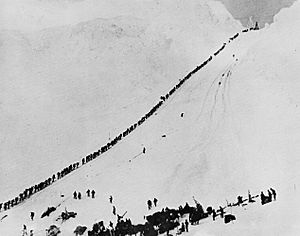
On July 12, 1897, Jack London (who was 21) sailed to join the Klondike Gold Rush. This adventure became the setting for some of his first successful stories. However, Jack's time in the harsh Klondike was very hard on his health. Like many others, he became sick because he didn't get enough food. He lost four of his front teeth. He also had constant pain in his hip and leg muscles. These struggles inspired his short story, "To Build a Fire". Many people think this is his best story.
When Jack returned to California in 1898, he worked hard to get his stories published. This struggle is described in his novel Martin Eden. His first story published after high school was "To the Man On Trail". He almost gave up writing when a magazine offered him only five dollars for it. But then, another magazine paid him $40 for his story "A Thousand Deaths". This was the first real money he earned from writing.
Jack London started his writing career when new printing technologies made magazines cheaper to produce. This led to a huge increase in popular magazines. There was a big demand for short stories. By 1900, he earned $2,500 from writing. That would be like earning about $90,000 today!
In early 1903, London sold The Call of the Wild to a magazine for $750. He also sold the book rights to a publisher. The publisher's advertising helped the book become a quick success.
Jack London became good friends with the poet George Sterling. Jack called Sterling "Greek" because of his nose and classic looks. Jack signed his letters as "Wolf". London later wrote about Sterling in his books.
Jack London loved books. He collected a personal library of 15,000 books. He called his books "the tools of my trade" because they helped him write.
Jack London's Marriages
Jack London married Elizabeth Mae "Bessie" Maddern on April 7, 1900. This was the same day his book The Son of the Wolf was published. Bessie had been a friend for several years. They both said they were marrying out of friendship, not love. They believed they would have strong children together.
Bessie had helped Jack study for his college entrance exams. They also enjoyed taking and developing photos together. This was the start of Jack's love for photography.
During their marriage, Jack wrote one of his most famous books, The Call of the Wild. Their first child, Joan, was born in 1901. Their second child, Bessie "Becky", was born in 1902.
By 1903, their marriage was difficult. Jack told Bessie he was leaving. They divorced on November 11, 1904.
After divorcing Bessie, Jack London married Charmian Kittredge in 1905. Charmian was five years older than Jack. They had met before his first marriage. They became close after Jack was injured and Charmian cared for him. They shared similar political beliefs, especially about socialism.
Many people said Charmian was Jack's "soul-mate." They traveled a lot together. This included a long trip on their yacht, the Snark, to Hawaii and Australia in 1907. Many of Jack's stories are based on his visits to Hawaii.
Jack London as a War Correspondent
In early 1904, Jack London became a reporter for a newspaper. He was sent to cover the Russo-Japanese War. He arrived in Japan in January 1904. He was arrested by Japanese officials several times for getting too close to the war zones without permission.
He was released each time. Once, he was even released because President Theodore Roosevelt personally stepped in to help. London left the war front in June 1904.
Jack London's Ranch Life
In 1905, Jack London bought a large ranch in Glen Ellen, California. It was about 1,000 acres. He loved the ranch very much. He said, "Next to my wife, the ranch is the dearest thing in the world to me." He wanted the ranch to be a successful business. He even said he wrote books just to buy more land for his ranch.
London studied many farming books and scientific texts. He wanted to create a farming system that was good for the environment. He was proud to have the first concrete silo in California. He hoped to use ideas from Asian farming in the United States. He hired skilled workers to build things on his ranch.
However, the ranch did not make money. Some people think his ideas were good but too early for their time. Others say he was not a good manager because he was often away. He spent about six months a year away from his ranch between 1910 and 1916.
London spent a lot of money to build a huge stone house called Wolf House on his property. It was 15,000 square feet. But just before he and Charmian were going to move in, the house was destroyed by fire.
Jack London's last visit to Hawaii lasted eight months. He met many important people there. He returned to his ranch in July 1916. He was suffering from kidney problems, but he kept working.
Today, the ranch and the ruins of Wolf House are a National Historic Landmark. They are protected as Jack London State Historic Park.
Jack London's Views and Beliefs
Animal Rights Activism
Jack London saw how circus animals were treated badly during training. Because of this, he wrote two novels, Jerry of the Islands and Michael, Brother of Jerry. These books included a message asking people to learn more about animal cruelty.
In 1918, a group called the Jack London Club was created. It aimed to teach people about cruelty to circus animals. They encouraged people to protest against it. Their efforts led to a temporary stop of trained animal acts in a big circus in 1925.
Political Beliefs
London wrote from a socialist point of view. This is clear in his novel The Iron Heel. His socialist ideas came from his own life experiences. He explained in an essay called "How I Became a Socialist" that his views were shaped by seeing people struggle. He decided he would not do hard physical work anymore. He said his focus on himself changed, and he became politically reborn. He often ended his letters by writing, "Yours for the Revolution."
London joined the Socialist Labor Party in 1896. He often gave speeches about socialism. In 1901, he joined the new Socialist Party of America. He ran for mayor of Oakland twice but did not win. He also traveled the country giving talks about socialism.
Later in his life, London had mixed feelings about socialism. He complained about some of the workers on his ranch. In 1916, he left the Socialist Party.
Views on Race
Jack London shared some common concerns of many European Americans in California about Asian immigration. He used the term "the yellow peril" in an essay in 1904. This idea also appeared in his story "The Unparalleled Invasion". This story describes a future where China's population grows too large. Western nations then use biological warfare to stop them. London did admit that his fears about China might come from his own "Western race-egotism."
However, many of London's short stories show a lot of understanding for characters from different backgrounds. He wrote about Mexican, Asian, and Hawaiian characters with empathy. His writings were popular in Japan. Japanese readers felt he showed them in a good light.
In his story "Koolau the Leper," London describes a Hawaiian man with leprosy. This man fights off an entire army to avoid capture. London calls him a "magnificent rebel." This character was based on a real Hawaiian leper who resisted capture in 1893.
In 1996, a street in Whitehorse, Yukon, was named "Jack London Boulevard." But protests about London's views on race caused the city to change the name back.
After boxer Jack Johnson became the first black world heavyweight champion in 1908, London asked for a "great white hope" to defeat Johnson. He wrote, "Jim Jeffries must now emerge... The White Man must be rescued."
Eugenics
London, like some other writers of his time, supported eugenics. This was a belief that humans could be improved through "good breeding." It was part of a scientific idea that people could be ranked by race and background. London wrote that he believed "the future belongs to eugenics."
His novel Before Adam (1906–07) shows some of these ideas. In another book, The Valley of the Moon, he focused on the idea of "real Americans" being Anglo-Saxon. However, when he lived in Hawaii, he saw different races marrying freely. He noted that "little Hawaii, with its hotch potch races, is making a better demonstration than the United States."
Jack London's Death
Jack London died on November 22, 1916, at his ranch. He had been a strong man, but he suffered from several serious illnesses. He had scurvy from his time in the Klondike. During his travels on the Snark, he and Charmian also caught tropical infections. When he died, he was suffering from kidney failure.
London's ashes were buried on his property. It was near where the Wolf House once stood. His funeral was small, with only close friends and family. He was buried under a mossy boulder. After his wife Charmian died in 1955, her ashes were buried next to him. The buildings and land are now part of Jack London State Historic Park.
Accusations of Plagiarism
Jack London was sometimes accused of plagiarism. This means using someone else's work without giving them credit. He was a very successful writer, and he wrote a lot. He also bought story ideas from other writers. He used events from newspaper articles as material for his stories.
In 1901, two similar stories appeared. One was London's "Moon-Face". The other was by Frank Norris. London said both writers based their stories on the same newspaper report.
A writer named Egerton Ryerson Young claimed that London's The Call of the Wild (1903) was taken from Young's book. London said he did use it as a source. He claimed he had even written a letter to Young to thank him.
In 1906, a newspaper showed how London's short story "Love of Life" was similar to an article by other writers. London said the newspaper did not accuse him of "plagiarism," but only of having similar events. He said he was "guilty" of that.
The most serious accusation was about a chapter in his novel The Iron Heel (1908). This chapter was almost the same as an essay by Frank Harris. Harris was very angry. London said he had found a copy of the article in an American newspaper. He thought it was a real speech by a bishop.
Jack London's Famous Works
Short Stories
Jack London's short stories are known for their strong writing. "To Build a Fire" is his most famous short story. It is set in the harsh Klondike. It tells the story of a man who ignores a warning about traveling alone in very cold weather. He falls through the ice and must quickly build a fire to survive. London wrote two versions of this story. The first was for a children's magazine. The second, more serious version, was published later.
Other stories from the Klondike include "All Gold Canyon" and "Love of Life". "The Law of Life" is about an old Native American man left to die by his tribe.
London loved boxing and was an amateur boxer himself. "A Piece of Steak" is a story about a boxing match between an older and younger boxer. "The Mexican" combines boxing with a social message. It's about a young Mexican man who fights to earn money for a revolution.
Several of London's stories are considered science fiction. "The Unparalleled Invasion" describes a war using germs. "The Shadow and the Flash" is about two brothers trying to become invisible. "The Red One" is about an island tribe controlled by an object from space.
Many collections of his short stories were published during his life or soon after he died. Most of these stories are set in the Klondike or the Pacific.
Novels
Jack London's most famous novels are The Call of the Wild, White Fang, The Sea-Wolf, The Iron Heel, and Martin Eden.
His publisher once said that Jack's fiction was "the very best kind of work" in America. Critics have called The Call of the Wild "a beautiful prose poem" and a "masterpiece."
The Sea-Wolf is famous for its character, Wolf Larsen. One critic called him "a tremendous creation."
The Iron Heel is a dystopian novel. It imagines a future society that is not good. It influenced other famous dystopian books. This novel clearly shows London's socialist political ideas. The Star Rover (1915) is also a science fiction novel.
Legacy and Honors
- Mount London, a mountain on the border of Alaska and British Columbia, is named after him.
- Jack London Square in Oakland, California, is named for him. It is on the waterfront.
- The United States Postal Service honored him with a postage stamp in 1986.
- Jack London Lake is a mountain lake in Russia named after him.
- Jack London has been shown in movies and TV shows. Actors like Michael O'Shea and Aaron Ashmore have played him.
Images for kids
See also
 In Spanish: Jack London para niños
In Spanish: Jack London para niños
- List of celebrities who own wineries and vineyards
- The story of eyewitness by Jack London



